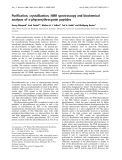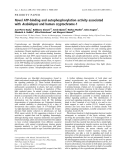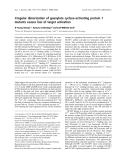
Photoreceptor
-
Arrestin is one of the key proteins for the termination of G protein signaling. ActivatedG protein-coupled receptors (GPCRs) are specifically phosphorylatedby G protein-coupledreceptor kinases (GRKs) and then bindto arrestins to preclude the receptor/G protein interaction, resulting in quenching of the following signal transduction. Vertebrates possess two types of arrestin; visual arrestin expressed exclusively in photoreceptor cells in retinae andpineal organs, andb-arrestin, which is expressedubiquitously....
 7p
7p  tumor12
tumor12
 22-04-2013
22-04-2013
 46
46
 2
2
 Download
Download
-
Thea-phycoerythrocyanin subunits of the different phy-coerythrocyanin complexes of the phycobilisomes from the cyanobacterium Mastigocladus laminosusperform a remarkable photochemistry. Similar to phytochromes – the photoreceptors of higher plants – the spectral pro-perties of the molecule reversibly change according to the irradiation wavelength. To enable extensive analyses,the protein has been produced at high yield by improving purification protocols.
 10p
10p  tumor12
tumor12
 22-04-2013
22-04-2013
 46
46
 3
3
 Download
Download
-
Cryptochromes are blue-light photoreceptors sharing sequence similarity to photolyases, a class of flavoenzymes catalyzing repair ofUV-damagedDNAvia electron transfer mechanisms. Despite significant amino acid sequence simi-larity in both catalytic and cofactor-binding domains, cryptochromes lack DNA repair functions associated with photolyases, and the molecular mechanism involved in cryptochrome signaling remains obscure.
 8p
8p  tumor12
tumor12
 20-04-2013
20-04-2013
 38
38
 3
3
 Download
Download
-
Phytochromes are photoreceptor proteins that monitor the light environ-ment and regulate a variety of photomorphogenic responses to optimize the growth and development of plants. Phytochromes comprise N-terminal photosensory and C-terminal regulatory domains. They are mutually pho-toconvertible between a red-light-absorbing (Pr) and a far-red-light-absorb-ing (Pfr) form. Their interconversion by light stimuli initiates downstream signaling cascades.
 10p
10p  awards
awards
 05-04-2013
05-04-2013
 46
46
 4
4
 Download
Download
-
Guanylate cyclase-activating proteins (GCAPs) are neur-onal calcium sensors that activate membrane bound guanylate cyclases (EC 4.6.1.2.) of vertebrate photoreceptor cells when cytoplasmic Ca 2+ decreases during illumination. GCAPs contain fourEF-handCa 2+ -bindingmotifs, but the first EF-hand is nonfunctional. It was concluded that for GCAP-2, the loss of Ca 2+ -binding ability of EF-hand 1 resulted in a region that is crucial for targeting guanylate cyclase [Ermilov,A.N.,Olshevskaya, E.V.&Dizhoor,A.M. (2001) J. Biol. Chem.276, 48143–48148].
 9p
9p  awards
awards
 05-04-2013
05-04-2013
 49
49
 4
4
 Download
Download
-
The retinal pigment epithelium (RPE) is essential for main-tenance of photoreceptors and normally functions under conditions enriched with reactive oxygen species. RPE therefore expresses various defense enzymes against oxida-tive stress, including heme oxygenase-1 (HO-1). HO-1 catalyzes heme breakdown to release iron, carbon monox-ide, and biliverdin, which is reduced to bilirubin, a potent radical scavenger. HO-1 expression is induced by various environmental factors, which has been established as a def-ense mechanism....
 9p
9p  awards
awards
 05-04-2013
05-04-2013
 41
41
 4
4
 Download
Download
-
Bacterial phytochromes (Bphs) are ancestors of the well characterized plant photoreceptors. Whereas plant phyto-chromes perform their photoisomerization exclusively via a covalently bound bilin chromophore, Bphs are variable in their chromophore selection. This is demonstrated in the cyanobacterium CalothrixPCC7601 that expresses two Bphs, CphA and CphB. CphA binds phycocyanobilin (PCB) covalently, whereas CphB, lacking the covalently binding cysteine of the plant phytochromes, carries biliver-din IXa (BV) as the chromophore....
 10p
10p  dell39
dell39
 03-04-2013
03-04-2013
 44
44
 3
3
 Download
Download
-
Thepcd1mutant of pea lacks heme oxygenase (HO) activity required for the synthesis of the phytochrome chromophore and is consequently severely deficient in all responses mediated by the phytochrome family of plant photoreceptors. Here we describe the isolation of the gene encoding pea heme oxygenase 1 (PsHO1) and confirm the presence of a mutation in this gene in the pcd1 mutant.
 13p
13p  inspiron33
inspiron33
 26-03-2013
26-03-2013
 55
55
 4
4
 Download
Download
-
Mutations in the human Crumbs homologue 1 (CRB1) gene are a frequent cause of various forms of retinitis pigmentosa. The CRB1–membrane-asso-ciated palmitoylated protein (MPP)5 protein complex is thought to organ-ize an intracellular protein scaffold in the retina that is involved in maintenance of photoreceptor–Mu¨ller glia cell adhesion.
 14p
14p  inspiron33
inspiron33
 26-03-2013
26-03-2013
 42
42
 3
3
 Download
Download
-
Retinal photoreceptor phosphodiesterase (PDE6), a key enzyme for photo-transduction, consists of a catalytic subunit complex (Pab) and two inhibi-tory subunits (Pcs). Pabhas two noncatalytic cGMP-binding sites. Here, using bovine PDE preparations, we show the role of these cGMP-binding sites in PDE regulation.
 19p
19p  cosis54
cosis54
 05-01-2013
05-01-2013
 44
44
 5
5
 Download
Download
-
The visual photoreceptor rhodopsin undergoes a series of conformational changes upon light activation, eventually leading to the active metarhodop-sin II conformation, which is able to bind and activate the G-protein, transducin.
 13p
13p  cosis54
cosis54
 05-01-2013
05-01-2013
 29
29
 4
4
 Download
Download
-
Cone photoreceptors have faster light responses than rods and a higher demand for 11-cisretinal (11cRAL), the chromophore of visual pigments. RPE65 is the isomerohydrolase in the retinal pigment epithelium (RPE) that converts all-transretinyl ester to 11-cisretinol, a key step in the visual cycle for regenerating 11cRAL.
 14p
14p  cosis54
cosis54
 04-01-2013
04-01-2013
 29
29
 2
2
 Download
Download
-
Tuyển tập các báo cáo nghiên cứu về y học được đăng trên tạp chí y học Minireview cung cấp cho các bạn kiến thức về ngành y đề tài: The phytochrome red/far-red photoreceptor superfamily...
 0p
0p  thulanh20
thulanh20
 12-11-2011
12-11-2011
 53
53
 3
3
 Download
Download
CHỦ ĐỀ BẠN MUỐN TÌM


























